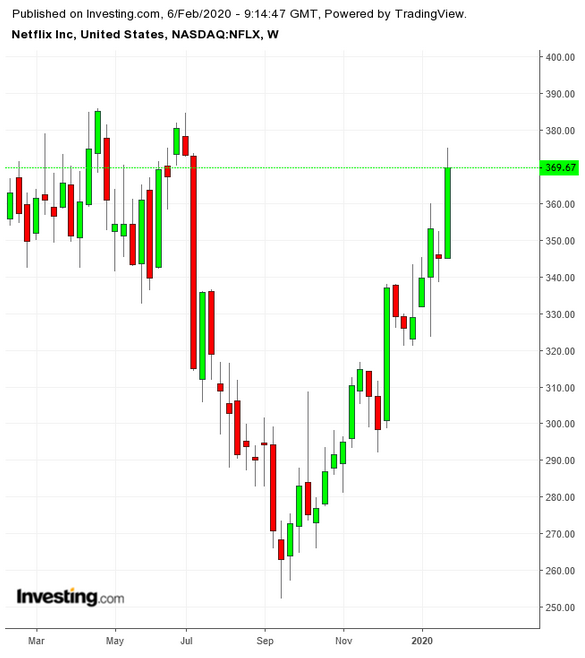Streaming-giant Netflix is enjoying an unexpected revival after its dismal performance in 2019. The stock has rapidly been gaining momentum, catching up with the upward trajectory of its fellow tech giants.
During the first five weeks of trading in 2020, Netflix (NASDAQ:NFLX) is the best-performing name among the FAANGs, the group of five mega cap tech stocks that includes Apple (NASDAQ:AAPL) and Amazon (NASDAQ:AMZN). At the time of writing, shares of Netflix were up more than 13% this year, closing yesterday at $369.67.

So, what’s behind the powerful advance that's slowly pushing Netflix to its highest level, $418.97, hit in early July 2018? It’s all about a reevaluation of the competitive landscape the video-streaming service is facing after the entrance of a variety of rivals into the market.
Since the company announced its fourth-quarter earnings on Jan. 21, followed this week by results from its biggest streaming rival Disney (NYSE:DIS), the analyst community is becoming convinced that it will take much longer for new entrants to meaningfully hurt Netflix (NASDAQ:NFLX).
Last month’s earnings report was Netflix’s first since the meaningful competition entered the market. Disney and Apple both launched their own streaming services, Disney+ and Apple TV+, in November. Going forward, AT&T's (NYSE:T) WarnerMedia plans to launch HBO Max in May and Comcast's (NASDAQ:CMCSA) NBCUniversal will introduce its Peacock service in the U.S. on July 15.
Though Netflix missed its forecast for U.S. subscriber growth for the third straight quarter, its overseas expansion continues unhindered. The Los Gatos, Calif.-based Netflix added 423,000 domestic subscribers in the fourth quarter, compared with its forecast of 600,000 additions.
Silver Lining: International Users
It also posted an increase of 8.3 million subscribers in overseas markets, more than the 7 million the company was expecting. It now has 167 million subscribers world-wide, including 60.4 million in the U.S.
Disney, on the other hand, said in its quarterly report Tuesday that it had already amassed a 28.6 million subscriber base for its Disney+ streaming service which was launched in November, exceeding analysts’ expectations of 20 million subscribers.
But some analysts see a silver lining for Netflix in these numbers. Guggenheim Partners raised its price target on Netflix last month from $400 per share to $420 per share, citing strong global subscriptions growth.
“Annual viewing per member grew both globally and domestically ‘consistent with recent quarters’ – both of which support our confidence in Netflix’s multi-year, global subscriber growth potential,” Guggenheim analyst Michael Morris said in the note.
“The company did not see a specific, significant impact on kids or family viewing levels following the domestic launch of Disney+ in November.”
Analysts at BofA have a similar favorable view about Netflix, reiterating their buy rating on the stock with a price target of $426.
“It is clear Disney+ engagement trails that of Netflix and this reinforces our view that Disney+ is not a substitute,” analyst Nat Schindler said in a note, adding that viewing hours per Disney+ subscriber “widely trail those of Netflix.”
Bottom Line
The journey upward for Netflix's stock has largely been unhindered during the past decade. But with the increasing competition, rising costs and saturation in the domestic market, it seems increasingly difficult for the streaming giant to repeat that performance. That being said, Netflix has the ability to make up for its weakness in the domestic market by aggressively growing its international presence.
